Page 499 of 1449
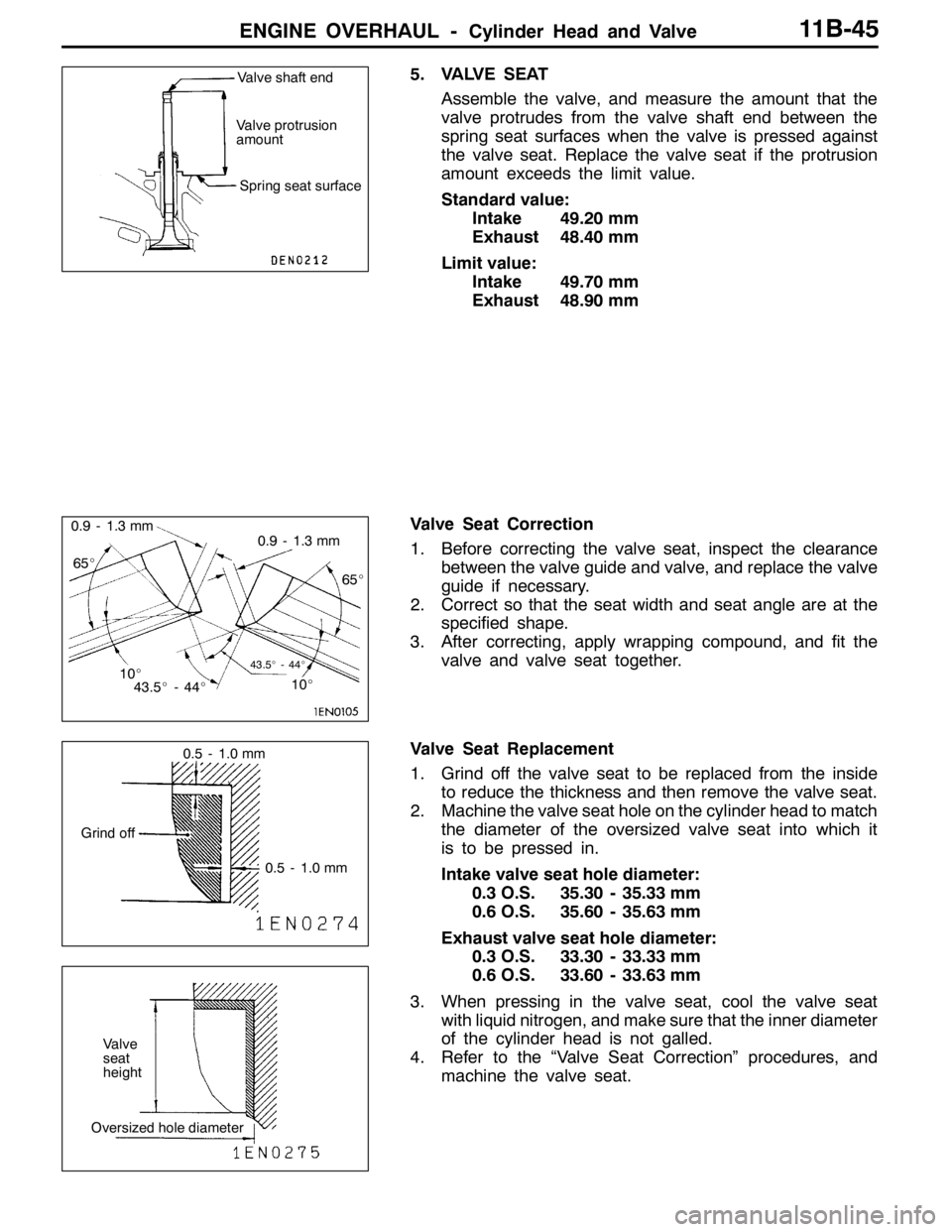
ENGINE OVERHAUL -Cylinder Head and Valve11B-45
5. VALVE SEAT
Assemble the valve, and measure the amount that the
valve protrudes from the valve shaft end between the
spring seat surfaces when the valve is pressed against
the valve seat. Replace the valve seat if the protrusion
amount exceeds the limit value.
Standard value:
Intake 49.20 mm
Exhaust 48.40 mm
Limit value:
Intake 49.70 mm
Exhaust 48.90 mm
Valve Seat Correction
1. Before correcting the valve seat, inspect the clearance
between the valve guide and valve, and replace the valve
guide if necessary.
2. Correct so that the seat width and seat angle are at the
specified shape.
3. After correcting, apply wrapping compound, and fit the
valve and valve seat together.
Valve Seat Replacement
1. Grind off the valve seat to be replaced from the inside
to reduce the thickness and then remove the valve seat.
2. Machine the valve seat hole on the cylinder head to match
the diameter of the oversized valve seat into which it
is to be pressed in.
Intake valve seat hole diameter:
0.3 O.S. 35.30 - 35.33 mm
0.6 O.S. 35.60 - 35.63 mm
Exhaust valve seat hole diameter:
0.3 O.S. 33.30 - 33.33 mm
0.6 O.S. 33.60 - 33.63 mm
3. When pressing in the valve seat, cool the valve seat
with liquid nitrogen, and make sure that the inner diameter
of the cylinder head is not galled.
4. Refer to the “Valve Seat Correction” procedures, and
machine the valve seat.Valve shaft end
Spring seat surface Valve protrusion
amount
10_ 65_
10_65_ 0.9 - 1.3 mm
0.9 - 1.3 mm
43.5_-44_43.5_-44_
0.5 - 1.0 mm
0.5 - 1.0 mm Grind off
Valve
seat
height
Oversized hole diameter
Page 507 of 1449
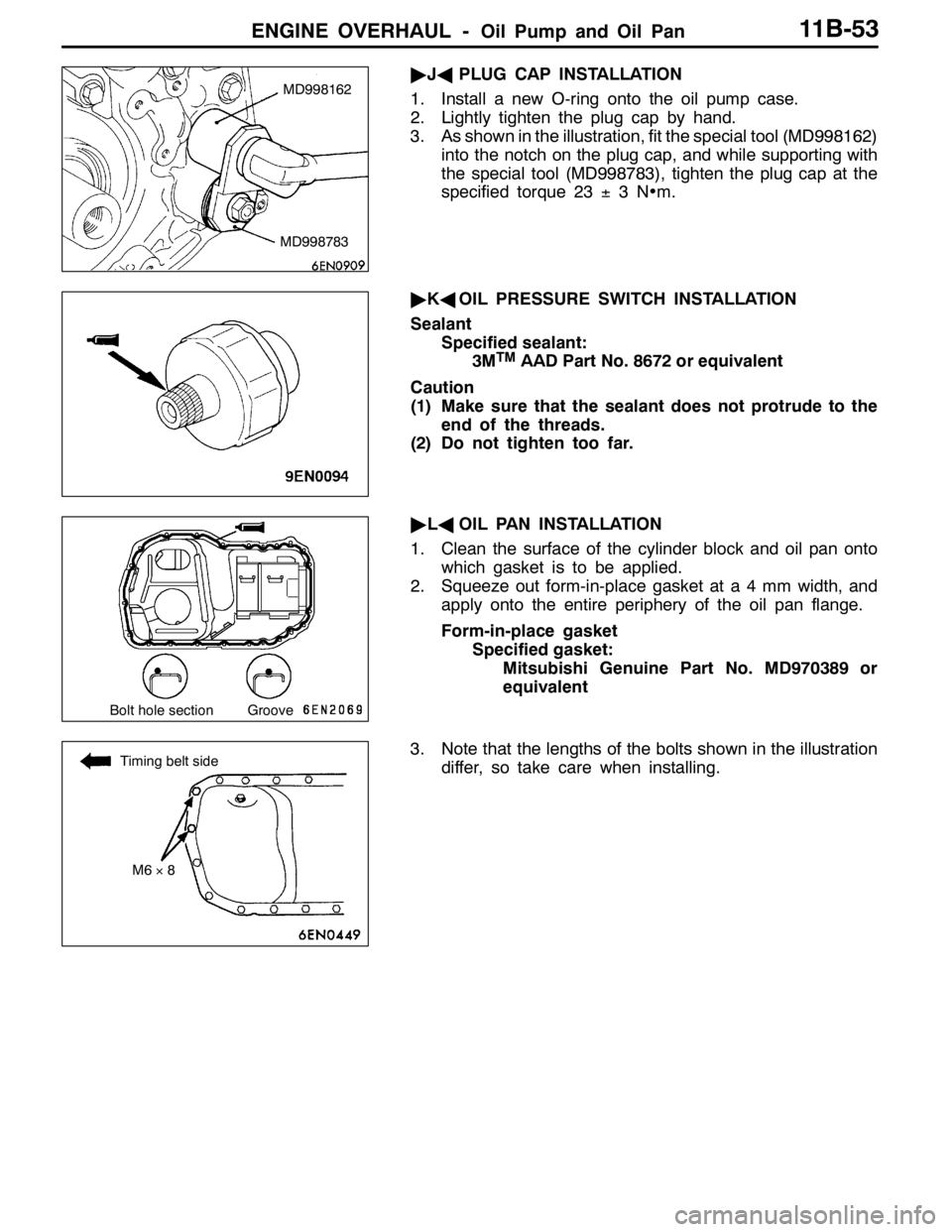
ENGINE OVERHAUL -Oil Pump and Oil Pan11B-53
"JAPLUG CAP INSTALLATION
1. Install a new O-ring onto the oil pump case.
2. Lightly tighten the plug cap by hand.
3. As shown in the illustration, fit the special tool (MD998162)
into the notch on the plug cap, and while supporting with
the special tool (MD998783), tighten the plug cap at the
specified torque 23±3N•m.
"KAOIL PRESSURE SWITCH INSTALLATION
Sealant
Specified sealant:
3M
TMAAD Part No. 8672 or equivalent
Caution
(1) Make sure that the sealant does not protrude to the
end of the threads.
(2) Do not tighten too far.
"LAOIL PAN INSTALLATION
1. Clean the surface of the cylinder block and oil pan onto
which gasket is to be applied.
2. Squeeze out form-in-place gasket at a 4 mm width, and
apply onto the entire periphery of the oil pan flange.
Form-in-place gasket
Specified gasket:
Mitsubishi Genuine Part No. MD970389 or
equivalent
3. Note that the lengths of the bolts shown in the illustration
differ, so take care when installing.
MD998162
MD998783
Bolt hole section Groove
Timing belt side
M6×8
Page 517 of 1449
ENGINE OVERHAUL -Piston and Connecting Rod11B-63
2. CRANKSHAFT PIN OIL CLEARANCE (PLASTIC
GAUGE METHOD)
(1) Wipe off the oil from the crankshaft pin and connecting
rod bearing.
(2) Set a plastic gauge as long as the bearing width
on the pin shaft so that straightly aligned with the
shaft centre.
(3) Carefully set the connecting rod cap, and tighten the
nut at the specified torque 20±2N•m+90_to
94_
(4) Remove the nut, and carefully remove the connecting
rod cap.
(5) Measure the width of the crushed plastic gauge (at
the section crushed the most) with the scale printed
on the plastic gauge bag.
Standard value: 0.03 - 0.05 mm
Limit value: 0.1 mm
Page 522 of 1449
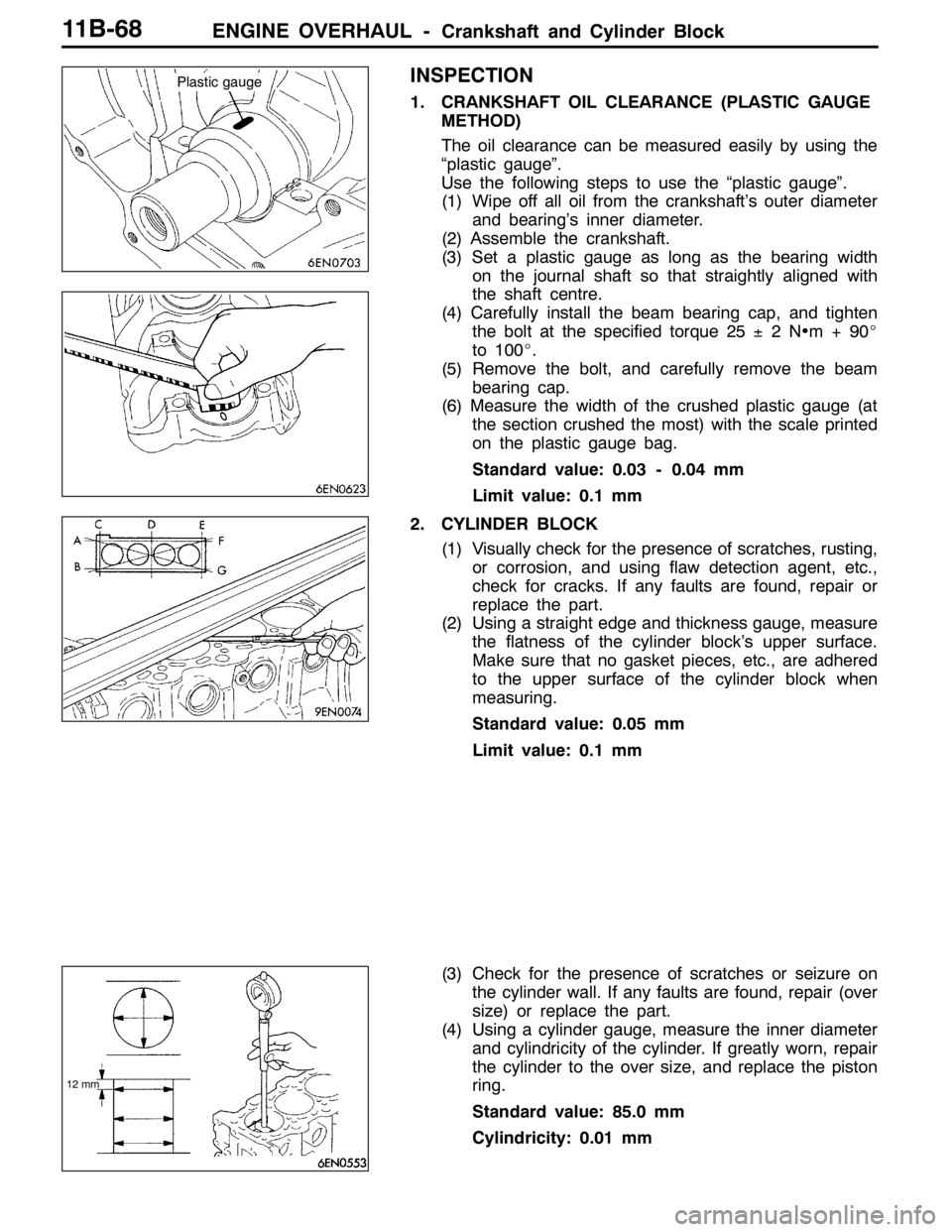
ENGINE OVERHAUL -Crankshaft and Cylinder Block11B-68
INSPECTION
1. CRANKSHAFT OIL CLEARANCE (PLASTIC GAUGE
METHOD)
The oil clearance can be measured easily by using the
“plastic gauge”.
Use the following steps to use the “plastic gauge”.
(1) Wipe off all oil from the crankshaft’s outer diameter
and bearing’s inner diameter.
(2) Assemble the crankshaft.
(3) Set a plastic gauge as long as the bearing width
on the journal shaft so that straightly aligned with
the shaft centre.
(4) Carefully install the beam bearing cap, and tighten
the bolt at the specified torque 25±2N•m+90_
to 100_.
(5) Remove the bolt, and carefully remove the beam
bearing cap.
(6) Measure the width of the crushed plastic gauge (at
the section crushed the most) with the scale printed
on the plastic gauge bag.
Standard value: 0.03 - 0.04 mm
Limit value: 0.1 mm
2. CYLINDER BLOCK
(1) Visually check for the presence of scratches, rusting,
or corrosion, and using flaw detection agent, etc.,
check for cracks. If any faults are found, repair or
replace the part.
(2) Using a straight edge and thickness gauge, measure
the flatness of the cylinder block’s upper surface.
Make sure that no gasket pieces, etc., are adhered
to the upper surface of the cylinder block when
measuring.
Standard value: 0.05 mm
Limit value: 0.1 mm
(3) Check for the presence of scratches or seizure on
the cylinder wall. If any faults are found, repair (over
size) or replace the part.
(4) Using a cylinder gauge, measure the inner diameter
and cylindricity of the cylinder. If greatly worn, repair
the cylinder to the over size, and replace the piston
ring.
Standard value: 85.0 mm
Cylindricity: 0.01 mm
Plastic gauge
12 mm
Page 931 of 1449
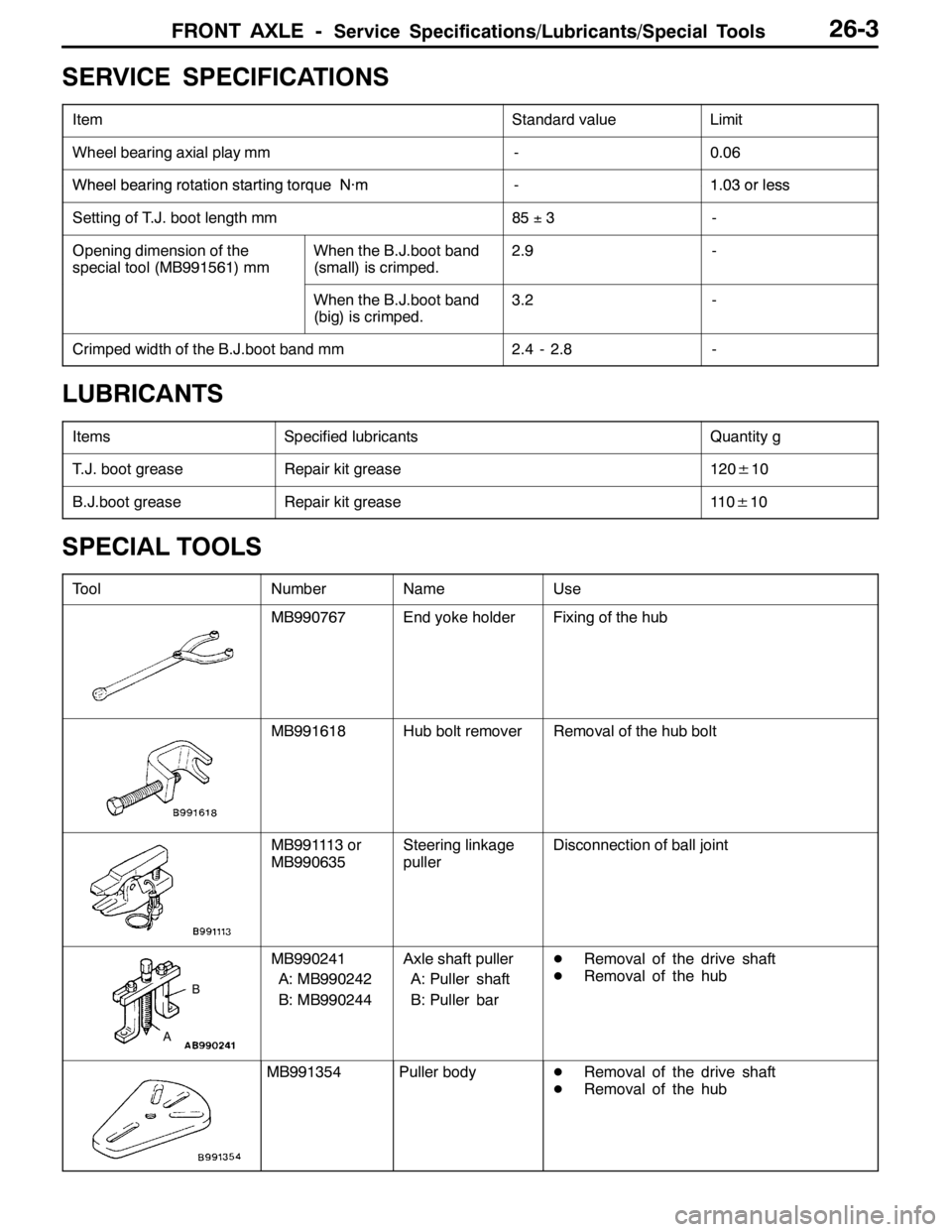
FRONT AXLE -Service Specifications/Lubricants/Special Tools26-3
SERVICE SPECIFICATIONS
ItemStandard valueLimit
Wheel bearing axial play mm-0.06
WheelbearingrotationstartingtorqueN·m-103orlessWheelbearing rotation startingtorqueN·m-1.03orless
Setting of T.J. boot length mm85±3-
Opening dimension of the
special tool (MB991561) mmWhen the B.J.boot band
(small) is crimped.2.9-
When the B.J.boot band
(big) is crimped.3.2-
Crimped width of the B.J.boot band mm2.4 - 2.8-
LUBRICANTS
ItemsSpecified lubricantsQuantity g
T.J. boot greaseRepair kit grease120±10
B.J.boot greaseRepair kit grease11 0±10
SPECIAL TOOLS
ToolNumberNameUse
MB990767End yoke holderFixing of the hub
MB991618Hub bolt removerRemoval of the hub bolt
MB991113 or
MB990635Steering linkage
pullerDisconnection of ball joint
A
B
MB990241
A: MB990242
B: MB990244Axle shaft puller
A: Puller shaft
B: Puller barDRemoval of the drive shaft
DRemoval of the hub
MB991354Puller bodyDRemoval of the drive shaft
DRemoval of the hub
Page 997 of 1449
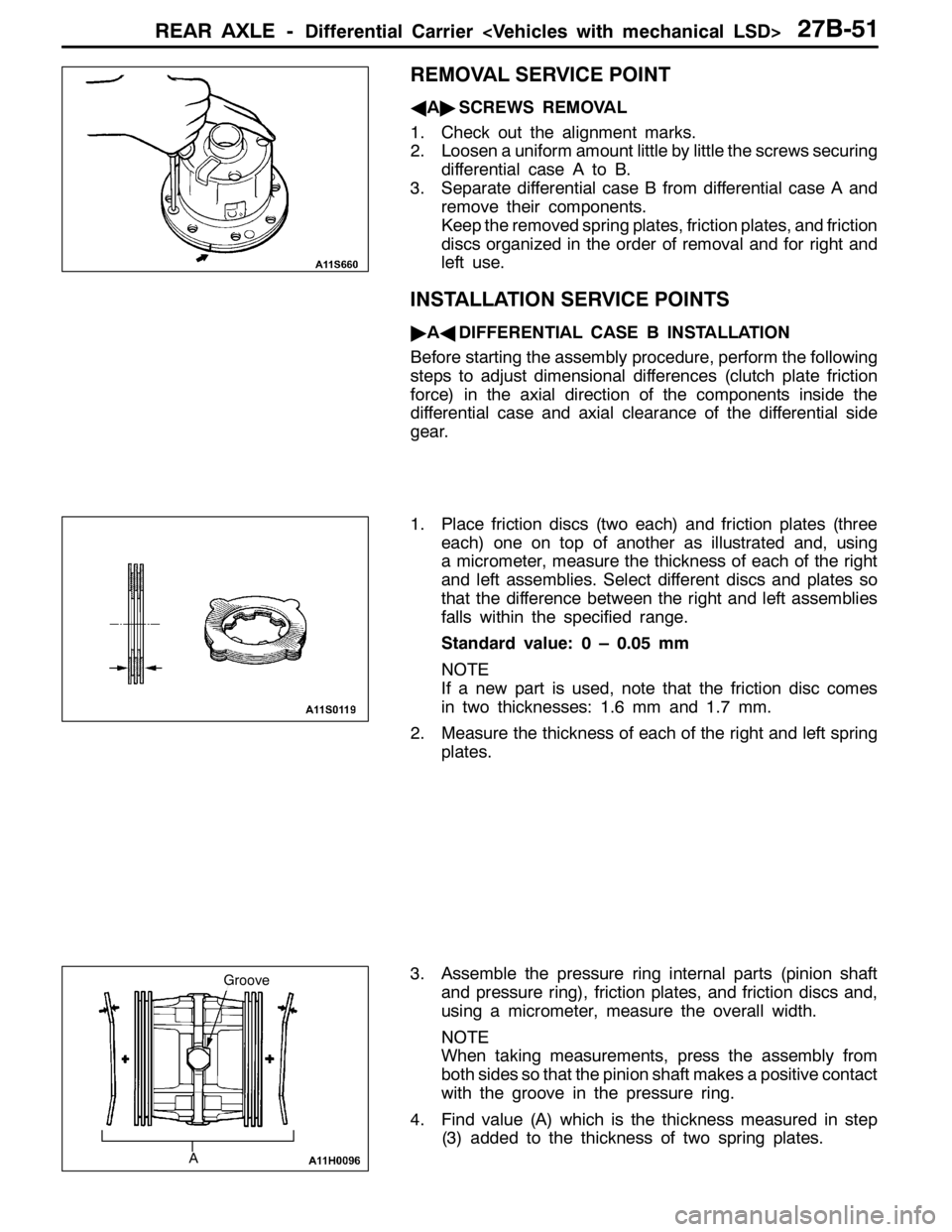
REAR AXLE -Differential Carrier 27B-51
REMOVAL SERVICE POINT
AA"SCREWS REMOVAL
1. Check out the alignment marks.
2. Loosen a uniform amount little by little the screws securing
differential case A to B.
3. Separate differential case B from differential case A and
remove their components.
Keep the removed spring plates, friction plates, and friction
discs organized in the order of removal and for right and
left use.
INSTALLATION SERVICE POINTS
"AADIFFERENTIAL CASE B INSTALLATION
Before starting the assembly procedure, perform the following
steps to adjust dimensional differences (clutch plate friction
force) in the axial direction of the components inside the
differential case and axial clearance of the differential side
gear.
1. Place friction discs (two each) and friction plates (three
each) one on top of another as illustrated and, using
a micrometer, measure the thickness of each of the right
and left assemblies. Select different discs and plates so
that the difference between the right and left assemblies
falls within the specified range.
Standard value: 0 – 0.05 mm
NOTE
If a new part is used, note that the friction disc comes
in two thicknesses: 1.6 mm and 1.7 mm.
2. Measure the thickness of each of the right and left spring
plates.
3. Assemble the pressure ring internal parts (pinion shaft
and pressure ring), friction plates, and friction discs and,
using a micrometer, measure the overall width.
NOTE
When taking measurements, press the assembly from
both sides so that the pinion shaft makes a positive contact
with the groove in the pressure ring.
4. Find value (A) which is the thickness measured in step
(3) added to the thickness of two spring plates.
A
Groove
Page 1118 of 1449
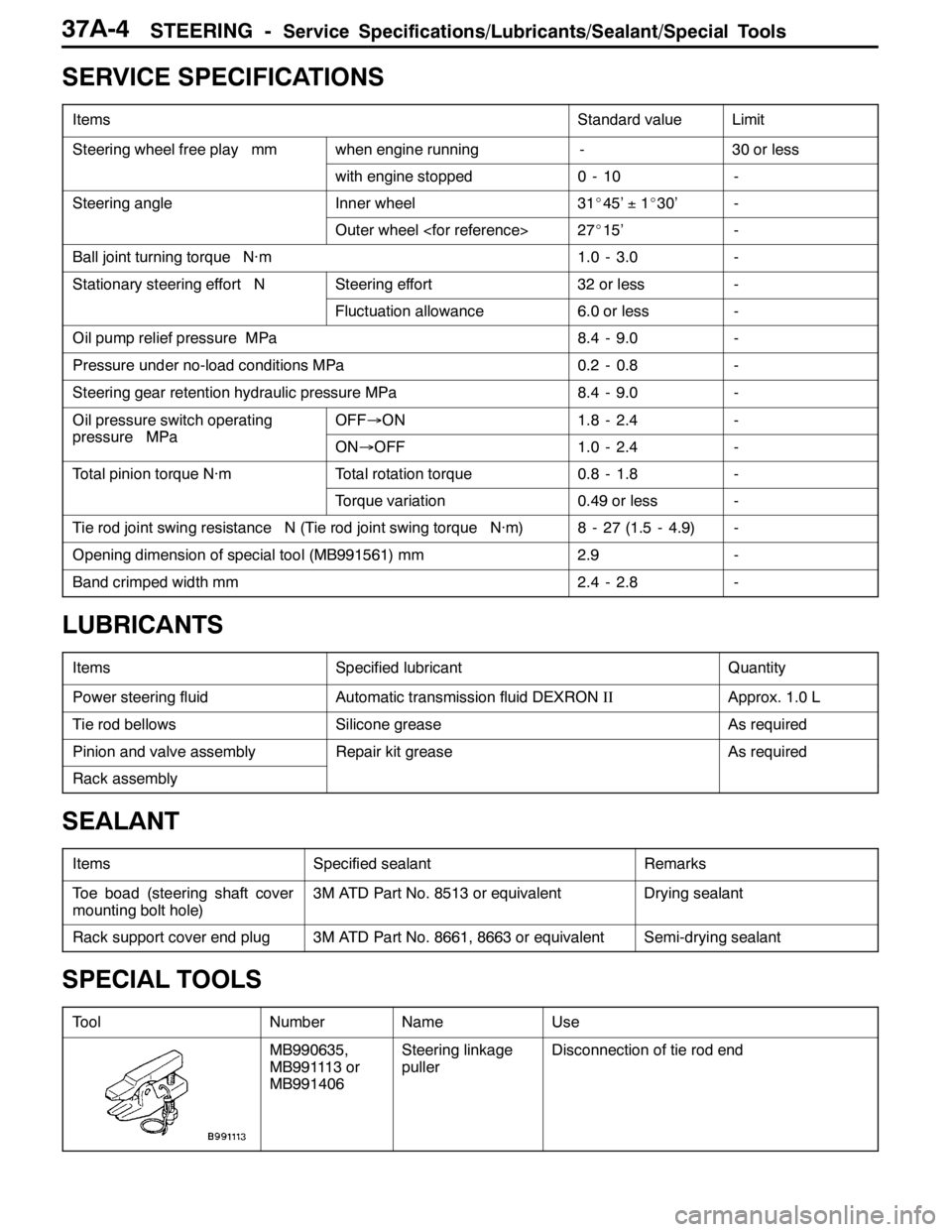
STEERING -Service Specifications/Lubricants/Sealant/Special Tools37A-4
SERVICE SPECIFICATIONS
ItemsStandard valueLimit
Steering wheel free play mmwhen engine running-30 or less
with engine stopped0-10-
Steering angleInner wheel31_45’±1_30’-
Outer wheel 27_15’-
Ball joint turning torque N·m1.0 - 3.0-
Stationary steering effort NSteering effort32 or less-
Fluctuation allowance6.0 or less-
Oil pump relief pressure MPa8.4 - 9.0-
Pressure under no-load conditions MPa0.2 - 0.8-
Steering gear retention hydraulic pressure MPa8.4 - 9.0-
Oil pressure switch operating
pressureMPa
OFF→ON1.8 - 2.4-
pressure MPaON→OFF1.0 - 2.4-
Total pinion torque N·mTotal rotation torque0.8 - 1.8-
Torque variation0.49 or less-
Tie rod joint swing resistance N (Tie rod joint swing torque N·m)8 - 27 (1.5 - 4.9)-
Opening dimension of special tool (MB991561) mm2.9-
Band crimped width mm2.4 - 2.8-
LUBRICANTS
ItemsSpecified lubricantQuantity
Power steering fluidAutomatic transmission fluid DEXRONIIApprox. 1.0 L
Tie rod bellowsSilicone greaseAs required
Pinion and valve assemblyRepair kit greaseAs required
Rack assembly
SEALANT
ItemsSpecified sealantRemarks
Toe boad (steering shaft cover
mounting bolt hole)3M ATD Part No. 8513 or equivalentDrying sealant
Rack support cover end plug3M ATD Part No. 8661, 8663 or equivalentSemi-drying sealant
SPECIAL TOOLS
ToolNumberNameUse
MB990635,
MB991113 or
MB991406Steering linkage
pullerDisconnection of tie rod end
Page 1142 of 1449
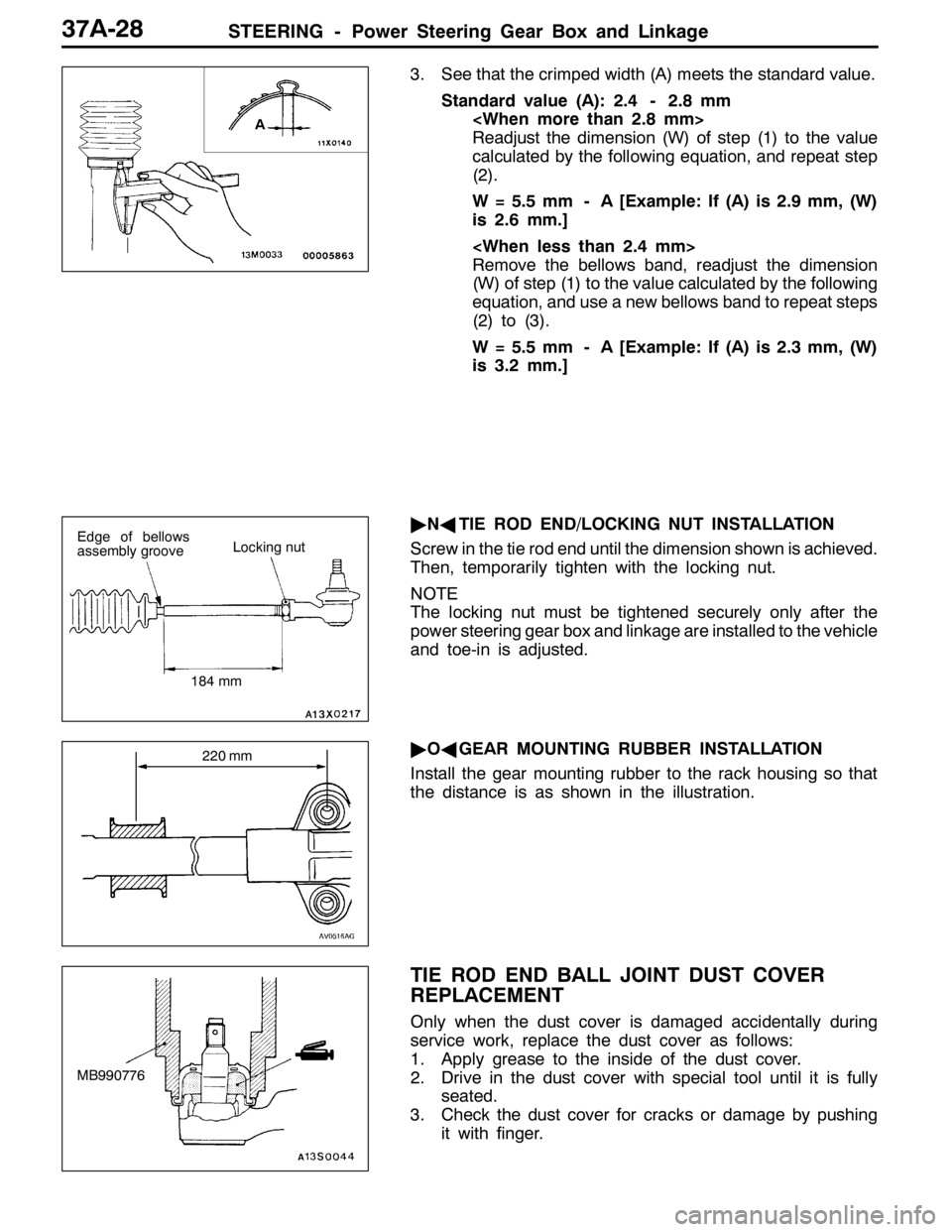
STEERING - Power Steering Gear Box and Linkage37A-28
3. See that the crimped width (A) meets the standard value.
Standard value (A): 2.4-2.8 mm
Readjust the dimension (W) of step (1) to the value
calculated by the following equation, and repeat step
(2).
W = 5.5 mm-A [Example: If (A) is 2.9 mm, (W)
is 2.6 mm.]
Remove the bellows band, readjust the dimension
(W) of step (1) to the value calculated by the following
equation, and use a new bellows band to repeat steps
(2) to (3).
W = 5.5 mm-A [Example: If (A) is 2.3 mm, (W)
is 3.2 mm.]
"NATIE ROD END/LOCKING NUT INSTALLATION
Screw in the tie rod end until the dimension shown is achieved.
Then, temporarily tighten with the locking nut.
NOTE
The locking nut must be tightened securely only after the
power steering gear box and linkage are installed to the vehicle
and toe-in is adjusted.
"OAGEAR MOUNTING RUBBER INSTALLATION
Install the gear mounting rubber to the rack housing so that
the distance is as shown in the illustration.
TIE ROD END BALL JOINT DUST COVER
REPLACEMENT
Only when the dust cover is damaged accidentally during
service work, replace the dust cover as follows:
1. Apply grease to the inside of the dust cover.
2. Drive in the dust cover with special tool until it is fully
seated.
3. Check the dust cover for cracks or damage by pushing
it with finger.
A
Edge of bellows
assembly grooveLocking nut
184 mm
220 mm
MB990776